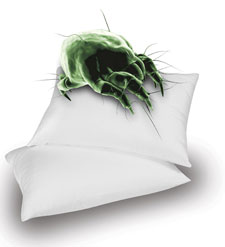Sneeze-Free Spring
Some spring-cleaning steps should help indoor allergens bite the dust
You can’t hide inside this spring and summer to avoid Washington’s cruel allergy season. And when you find out what’s lurking in your humble home, you won’t want to. That’s because indoor allergens — generally the byproduct of spider-like, microscopic dust mites — are just as bad, leaving you sneezing and itchy-eyed as surely as anything floating in the air outside.
”What we call a house dust mite is actually a microscopic insect that lives on our skin and tends to multiply in areas that are warm and humid,” says Dr. Dan Brody, an allergist working in Washington. ”It tends to be in places like mattresses, pillows, bedding and carpets. If you were to take the dust from any inhabited building and examine it under a microscope, or examine it for the presence of this allergen, it would be there.”

Control dust mites and other allergens in your home
That means Windex won’t do the trick when you get around to that much-needed spring cleaning.
The American Academy of Allergy Asthma and Immunology (AAAAI) offers a few tips on how to reduce indoor allergies when cleaning your home, particularly focusing on cleaning areas where indoor allergens may multiply.
Besides the obvious tidying and dusting, the AAAAI and Brody both point out that your bed is very popular with the flesh-eating dust bugs. Wash your blankets, sheets and pillowcases in 130-degree water and dry them in a hot dryer.
Brody also suggests purchasing non-allergenic cases for your mattress, pillows and other bedding.
”If you’re somebody that has an indoor allergy, presumably it’s going to be house dust mites. What you should do is buy special covers for your pillows and mattress, which prevent all the dust mites that are in the pillows and mattress from getting out and going into your nose.”
Removing carpeting, if that’s an option, as well as buying filters to clean the air, can also reduce indoor allergens.
”Special filters are very good at reducing the amount of indoor allergens,” says Brody. ”And you can put those in your furnace and heater system.”
This may also be a good time to start taking an over-the-counter medication so that when the allergy season peaks, you’ll be prepared.
”If you’re taking one of the available over-the-counter allergy medications like Zyrtec or Claritin, or their generic equivalents, and you’re still being bothered by sneezing, by eye itch, by nasal congestion, then you should go see a doctor,” recommends Brody.
Your doctor might prescribe another medicine, such as nasal spray, which just may do the trick.
”People should consult an allergist when it seems like they’re taking a lot of medicine and they’re still struggling with these things, then they should come see an allergist,” Brody says, adding that those who don’t suffer from allergies might not be so lucky this year.
”I once saw a man who was 81-years-old, who suddenly developed allergies. It can happen at anytime to anybody.”
For more information, visit the American Academy of Allergy Asthma and Immunology’s Web site, at www.aaaai.org .
Support Metro Weekly’s Journalism
These are challenging times for news organizations. And yet it’s crucial we stay active and provide vital resources and information to both our local readers and the world. So won’t you please take a moment and consider supporting Metro Weekly with a membership? For as little as $5 a month, you can help ensure Metro Weekly magazine and MetroWeekly.com remain free, viable resources as we provide the best, most diverse, culturally-resonant LGBTQ coverage in both the D.C. region and around the world. Memberships come with exclusive perks and discounts, your own personal digital delivery of each week’s magazine (and an archive), access to our Member's Lounge when it launches this fall, and exclusive members-only items like Metro Weekly Membership Mugs and Tote Bags! Check out all our membership levels here and please join us today!

















